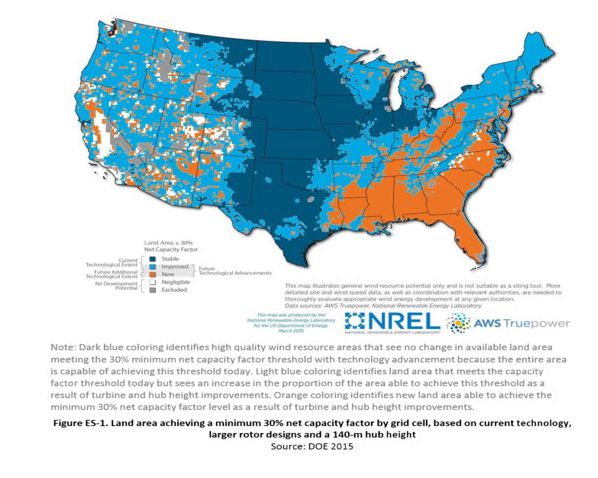WASHINGTON, May 20, 2015 – Wind energy already provides nearly 5% of the nation’s total electricity generation, but there is tremendous potential to expand production across all 50 states by embracing taller wind turbines, larger rotors, and other technical innovations. At least that’s one of the main messages in a new Department of Energy (DOE) report, “Enabling Wind Power Nationwide.”
Other key conclusions:· The deployment of taller wind turbines (already prevalent in Germany with average hub heights at 116 m) will expand U.S. land area available for wind deployment by 54%, while increasing heights to 140 m will increase that further to 67%, the authors noted. The geographic distribution for this expanded wind technical resource would include new regions such as the Southeast, as well as increasing the already cost- effective areas where wind power is currently installed
· Advancements in wind technologies have already yielded broad cost-competitive deployment in locations with high wind speeds. Market trends and technological innovations are increasingly unlocking cost-effective wind in regions with more moderate wind resources.
· Improvements in siting practices have contributed to the deployment of 65 gigawatts (GW) in cumulative installed wind capacity (as of 2014). Pursuing more moderate resource quality sites can and should be done in coordination with the broad stakeholder community for wind to coexist with the environment and federal and state agency missions.
· Innovations addressing the technical and economic challenges, as well as the environmental and human use considerations, are critical to realize the nation’s full wind power potential and value for all 50 states. As wind deployment reaches new heights and new regions, additional environmental and human use factors will need to be considered and addressed. This includes the potential for new or additional interactions with wildlife such as birds and bats, as well as effects on their habitats. Impacts related to human use concerns, such as civilian and military radars, must be also evaluated. Continued research and development, as well as federal, state and local inter- agency coordination, on potential impacts and options for mitigation and resolution are required to ensure responsible deployment. See graphic below for more on wind resource potential.

For more news, go to www.agri-pulse.com.

